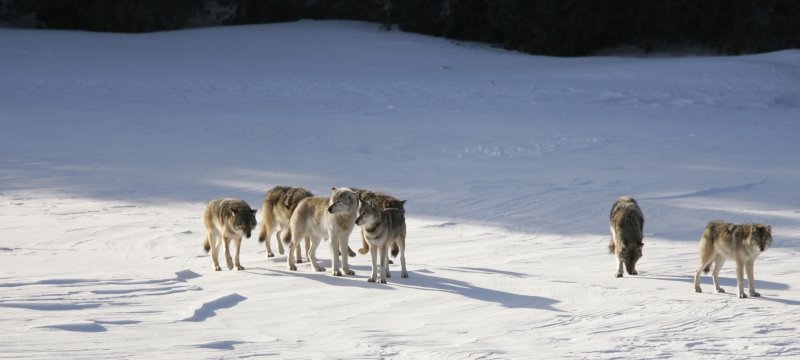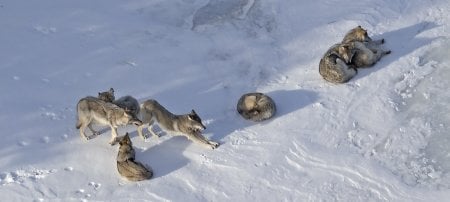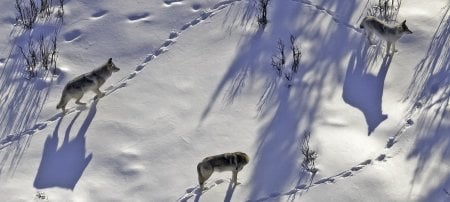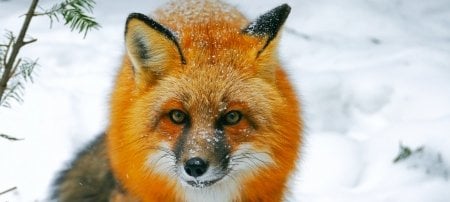The male wolf’s arrival via ice bridge in 1997 changed everything. On the heels of co-authoring a study in Science Advances, Isle Royale wolf-moose study co-leader Sarah Hoy explains how he triggered a series of knock-on events that impacted the national park’s forested ecosystem for decades.
As we grow older, it’s common to muse about our legacies. Have we enriched our community or benefited society? Will any of our achievements be remembered long after we’re gone? Like the George Bailey character played by Jimmy Stewart in the holiday film classic “It’s a Wonderful Life,” we may wonder if the world would be different if we’d never existed.
Beyond our individual existential examinations, humans can also remember, explore and learn from the important legacies of others who share our environment — including a single male wolf who effected dramatic change in Isle Royale National Park, the remote island chain and international biosphere also known as Minong, situated in North America’s Lake Superior.
The male wolf is identified as “M93” by scientists, but outside of scientific journals he is affectionately nicknamed “The Old Gray Guy.” That’s because his fur got lighter as he aged, a trait uncharacteristic to the island wolves.
Of course, he wasn’t always old. The Isle Royale wolf population has been studied since the late 1950s and is the focus of the longest-running predator-prey study in the world. But M93's story doesn’t begin until 1997, when he crossed a 15-mile ice bridge that temporarily connected Isle Royale to mainland Canada.
Prior to M93’s arrival, the Isle Royale wolves had been doing poorly. During the 1980s, the wolf population declined from 50 to 12 wolves due to an outbreak of canine parvovirus. Although the disease disappeared by the late 1980s, the wolves’ population didn’t recover.
About the Research
“The far-reaching effects of genetic process in a keystone predator species, grey wolves,” is co-authored by Sarah Hoy, Rolf Peterson, Leah Vucetich, Kristin Brzeski and
John Vucetich of Michigan Tech’s College of Forest Resources and Environmental Sciences and Philip Hedrick of the Arizona State University School of Life Sciences.
Designated a national park in 1931 and an international biosphere reserve in 1980, Isle Royale National Park
covers 850 square miles and is home to the longest-running predator-prey research
project in the world. Get acquainted with the wildlife of Isle Royale and access more resources here:
The reason for their failure to rebound wasn’t known at the time, but later research showed that inbreeding depression — a phenomenon where the offspring of two closely related individuals are less likely to survive or to successfully reproduce — was the cause. High levels of inbreeding occurred on Isle Royale because the wolf population was largely isolated from the mainland population. Ice bridges are the only way for wolves to reach the archipelago; they do not form every year and may only last a few days. Opportunities for wolves to move between the mainland and Isle Royale have been getting more limited over time as the climate warms.
High levels of inbreeding in the wolf population resulted in several problems, including an unusually low number of pups being born and surviving to adulthood. Scientists later discovered that many wolves in the population had been born with unusually shaped bones in their spines. Those types of spinal anomalies, known to be associated with inbreeding in domestic dogs, can be painful and affect mobility.
The fate of the wolf population started to change after the arrival of M93, an immigrant who was not related to any of the other wolves in the native population. He quickly became the breeding male of one of the three packs, which reduced overall levels of inbreeding, and he introduced some new genes into the population.
In addition to being unrelated to other wolves, M93 had another advantage — he was much larger than the native wolves. Having a large body size can benefit wolves when it comes to defending a territory or taking down large prey, such as moose, which are roughly eight times heavier than a wolf. Those advantages over the native inbred wolves meant that M93 became a very successful breeder. He produced a total of 34 pups during the eight years that he was an alpha male.

In the years following M93’s arrival, the wolf population started to recover, increasing to 30 wolves. Scientists also noted that wolves started to kill moose at a much higher rate than before, another sign that M93 had improved the health of the wolf population. In other words, M93, who died in 2006, had essentially rescued the wolf population by alleviating the inbreeding depression.
Unfortunately, the benefits that accompanied M93’s arrival were short-lived and started to fade by 2008. His great success as a breeder meant he quickly became related to the majority of wolves on the island — and after the death of his original mate, he began mating with his daughter. Concurrently, M93’s other offspring started breeding with each other.
The strong genes M93 contributed to the wolf population were eventually its downfall. For example, in 2008 it was estimated that 60% of the wolves’ gene pool was inherited from M93. As inbreeding became commonplace again, the population started to rapidly decline. By 2015 only two highly inbred wolves were left — a father and daughter pair that were also half-brother and sister. Those two wolves were unable to successfully reproduce.
"But the story of M93’s legacy does not end with the wolf population. It only brings us to the story of another iconic animal — moose."
Moose are the only large herbivores on Isle Royale and the main prey of wolves. In the decade following M93’s arrival, the reinvigorated wolf population preyed on moose at a higher rate than before, which caused the moose population to steadily decline. However, after 2008 when the genetic health of the wolf population deteriorated, so did the rate at which wolves preyed on moose. In turn, this caused the moose population to start increasing rapidly. In other words, the deterioration in the genetic health of the population essentially meant that wolves were no longer able to perform their ecological role as the top predator in the ecosystem.

M93’s Legacy Extends to the Forest
The changes in moose abundance led to changes in the rate at which moose browse on forest vegetation, most notably on balsam fir. Known as the most fragrant of natural Christmas trees, balsam fir is also the main food source for moose. It’s a common and important species in Isle Royale’s forests. Big changes in the number of moose can quickly cascade to impact forests because moose are large animals, with an average weight of 800 pounds, and consume massive amounts of vegetation — up to 30 pounds a day.
As the genetic health of the wolf population increased following M93’s arrival, the moose population declined, which led to a decline in the rate that moose were browsing on fir trees. As browse rates fell, fir trees started to grow at rates that hadn’t been observed for decades.
Then, as the genetic health of the wolf population deteriorated between 2008-2018, the increasing moose population led to a substantial increase in browsing on fir. Moose were munching branches faster than the fir trees could grow new ones. Such high browsing levels resulted in many young fir trees dying or failing to grow in height, creating major consequences for the forest by decreasing the number and rate that young fir trees can grow into mature canopy trees. Balsam fir is one of the most common tree species on Isle Royale, providing food and shelter for a wide array of other wildlife species. The impacts of moose browsing on fir had important implications across the wider Isle Royale ecosystem.
The Old Gray Guy’s Continuing Legacy
We have learned three general lessons from M93. First, that the arrival of a single individual can impact the genetic health and fitness of an entire predator population, and that those impacts can flow through the prey population and on to the forest and its ecological processes.
Second, M93’s legacy highlights the far-reaching and profound effects that genetic processes, such as inbreeding, can have on entire ecosystems. While the case of these island wolves may seem unique, it is concerning because many top predator populations around the world are becoming increasingly small, fragmented and isolated to the point that inbreeding has become a major concern due to factors such as habitat loss.
Lastly, the research highlights how tightly connected species are within ecosystems and how the health of one species can cascade to impact the health of another.
So next time you’re wondering if an individual makes a difference in the world, consider The Old Gray Guy and how his decision to walk across an ice bridge one cold and snowy day impacted an ecosystem for more than two decades.

Michigan Technological University is an R1 public research university founded in 1885 in Houghton, and is home to nearly 7,500 students from more than 60 countries around the world. Consistently ranked among the best universities in the country for return on investment, Michigan's flagship technological university offers more than 185 undergraduate and graduate degree programs in science and technology, engineering, computing, forestry, business, health professions, humanities, mathematics, social sciences, and the arts. The rural campus is situated just miles from Lake Superior in Michigan's Upper Peninsula, offering year-round opportunities for outdoor adventure.







Comments